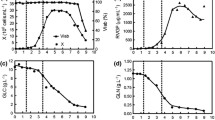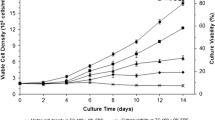Abstract
An animal protein-free medium was developed for Drosophila melanogaster S2 (S2AcGPV2) cells genetically modified to produce the rabies virus G glycoprotein (GPV). IPL-41, used as a basal medium, was supplemented with yeastolate, carbohydrates, amino acids and lipids aiming initially to reduce and further to eliminate the need of fetal bovine serum. The S2AcGPV2 cells were fully capable of growing in serum-free supplemented IPL-41 medium containing 6 g L−1 yeastolate ultrafiltrate, 10 g L−1 glucose, 3.5 g L−1 glutamine, 0.5 g L−1 fructose, 2 g L−1 lactose, 0.6 g L−1 tyrosine, 1.48 g L−1 methionine and 1% (v/v) lipid emulsion, reaching 19 × 106 cells mL−1. Maximum specific growth rate and cell productivity were 0.025 h−1 and 0.57 × 105 cells mL−1 h−1, respectively. Glucose and lactose were consumed during cell culture, but not fructose. Lactate concentration generally decreased during cell culture, while ammonium concentration reached 167 mg L−1, however, without noticeable deleterious effects on cell growth. GPV concentration values achieved were, however, modest in the proposed medium formulation.




Similar content being viewed by others
References
Bachmann AS, Corpuz G, Hareld WP et al (2004) A simple method for the rapid purification of copia virus-like particles from Drosophila Schneider 2 cells. J Virol Methods 115:159–165
Batista FRX, Pereira CA, Mendonça RZ et al (2005) Enhancement of Sf9 cells and baculovirus production employing Graces’s medium supplemented with milk whey ultrafiltrate. Cytotechnology 49:1–9
Chu L, Robinson DK (2001) Industrial choices for protein production by large-scale cell culture. Curr Opin Biotechnol 12:180–187
Donaldson MS, Shuler ML (1998) Low-cost serum free medium for the BTI-Tn5B1-4 insect cell line. Biotechnol Prog 14:573–579
Drews M, Paalme T, Vilu R (1995) The growth and nutrient utilisation of insect cell line Spodoptera frugiperda Sf9 in batch and continuous culture. J Biotechnol 40:187–198
Echalier G (1997) Composition of the body fluid of Drosophila and the design of culture media for Drosophila cells. In: Drosophila cells in culture. Academic Press, San Diego, pp 1–67
Galesi ALL, Pereira CA, Moraes AM (2007) Culture of transgenic Drosophila melanogaster Schneider 2 cells in serum-free media based on TC100 basal medium. Biotechnol J (in press). doi:10.1002/biot.200700048
Gaudin Y, Ruigrok RWH, Knossow M et al (1993). Low-pH Conformational changes of rabies virus glycoprotein and their role in membrane fusion. J Virol 67:1365–1372
Grisshammer R (2006) Understanding recombinant expression of membrane proteins. Curr Opin Biotechnol 17:337–340
Hewlett G (1991) Strategies for optimising serum-free media. Cytotechnology 5:3–14
Ikonomou L, Bastin G, Schneider YJ et al (2001) Design of an efficient medium for insect cell growth and recombinant protein production. In vitro Cell Dev Biol Anim 37:549–559
Ikonomou L, Schneider YJ, Agathos SN (2003) Insect cell culture for industrial production of recombinant proteins. Appl Microbiol Biot 62:1–20
Kioukia N, Nienow AW, Emery AN et al (1995) Physiological and environmental factors affecting the growth of insect cells and infection with baculovirus. J Biotecnol 38:243–251
Maiorella B, Inlow D, Shauger A et al (1988) Large-scale insect cell culture for recombinant protein production. Bio/Technol 6:1406–1410
Marteijn RL, Jurrius O, Dhont J et al (2003) Optimisation of a feed medium for fed-batch culture of insect cells using a genetic algorithm. Biotechnol Bioeng 81:269–278
Mendonça RZ, Palomares LA, Ramírez OT (1999) An insight into insect cell metabolism through selective nutrient manipulation. JBiotech 72:61–75
Mendonça RZ, Oliveira EC, Pereira CA, Lebrum I (2007) Effect of bioactive peptides isolated from yeastolate, lactalbumin and NZ case in the insect cell growth. Bioprocess Biosyst Eng 30:157–164
Mitsuhashi J (1989) In: Mitsuhashi J (ed) Invertebrate cell system applications. CRC Press, pp 3–20
Mosher JT, Crews ST (1999) Effecten reagent yields high trasnfection efficiencies with Drosophila melanogaster S2 cells. Qiagen News 4:7–9
Nybakken K, Vokes SA, Lin TY et al (2005) Genome-wide RNA interference screen in Drosophila melanogaster cells for new components of the Hh signaling pathway. Nat Genet 37:1323–1332
Oh SKW, Cha FKF et al (1995) Intracellular responses of productivity hybridomas subjected to high osmotic pressure. Biotechnol Bioeng 46:525–535
Palomares LA, López S, Ramírez OT (2004) Utilization of oxygen uptake rate to assess the role of glucose and glutamine in the metabolism of insect cell cultures. Biochem Eng J 19:87–93
Pérez O, Paolazzi CC (1997) Production methods for rabies vaccine. J Ind Microbiol Biot 18:340–347
Rupprecht CE, Smith JS, Fekadu M et al (1995) The ascension of wildlife rabies: a cause for public health concern or intervention? Emerg Infec Dis 1:101–114
Sissoëff L, Mousli M, England P et al (2005) Stable trimerization of recombinant rabies virus glycoprotein ectodomain is required for interaction with the p75NTR receptor. J Gen Virol 86:2543–2552
Southon A, Burke R, Norgate M et al (2004) Copper homoeostasis in Drosophila melonogaster S2 cells. Biochem J 383:303–309
Wang DI, Cooney CL, Demain AL et al (1979) Fermentation and enzyme technology. Wiley, New York
Yokomizo AY, Jorge SAC, Astray RM et al (2007) Rabies virus glycoprotein expression in Drosophila S2 cells. I. Functional recombinant protein in stable co-transfected cell line. Biotechnol J 2:102–109
Zimmerman AM, Vierck JL, O’ Really BA et al (2000) Formulation of defined medium to maintain cell health and viability in vitro. Methods Cell Sci 22:43–49
Acknowledgments
The authors acknowledge Coordenação de Aperfeiçoamento de Pessoal de Nível Superior (CAPES, Brasília, Brazil), Fundação de Amparo a Pesquisa do Estado de São Paulo (FAPESP grant no. 02/09482-3, São Paulo, Brazil) and Instituto Butantan (São Paulo, Brazil) for the financial support. The authors wish to acknowledge Prof Dr. Cláudio Alberto Torres Suazo (Federal University of São Carlos, Brazil) and team for amino acids analysis. We are also grateful to Prof Dr. Andreas Karoly Gombert and Saul Nitsche Rocha from University of São Paulo for sugars measurements.
Author information
Authors and Affiliations
Corresponding author
Additional information
Â. M. Moraes and C. A. Pereira are recipient of CNPq fellowships.
Rights and permissions
About this article
Cite this article
Batista, F.R.X., Pereira, C.A., Mendonça, R.Z. et al. Formulation of a protein-free medium based on IPL-41 for the sustained growth of Drosophila melanogaster S2 cells. Cytotechnology 57, 11–22 (2008). https://doi.org/10.1007/s10616-008-9153-0
Received:
Accepted:
Published:
Issue Date:
DOI: https://doi.org/10.1007/s10616-008-9153-0




